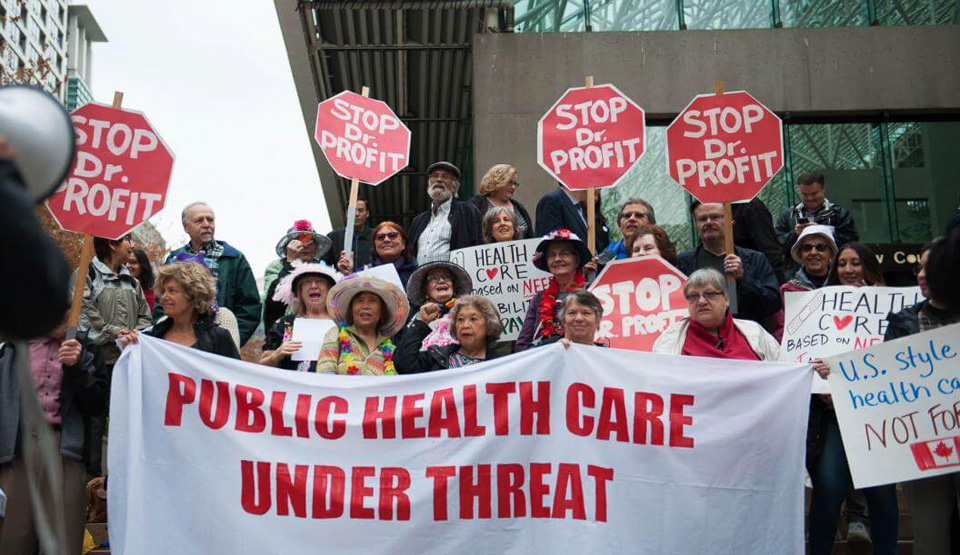
December 19, 2016 marked the 50th anniversary of Canada’s Medicare Act – the legislation which initiated the country’s single-payer public health system. It was passed in the House of Commons December 19, 1966 after a mass struggle led by the labor movement that had its roots in the plan created by Dr. Norman Bethune for a system of socialized medicine in Canada.
Tommy Douglas, then the Premier of Saskatchewan and leader of the provincial wing of the social democratic Co-operative Commonwealth Federation (CCF) party (forerunner of today’s New Democratic Party), introduced Medicare in that province. Douglas took on the powerful doctors’ lobby that saw medicine primarily as a business, not an essential service and human right. Saskatchewan’s doctors went on strike, but eventually came back to work, tails between their legs, overwhelmed by public support for this first introduction of socialized medicine in Canada.
But the opponents of Medicare have never given up their fight. The doctor business is quite profitable in Canada, particularly for specialists and those who run their practices like for-profit businesses.
Among these is Dr. Brian Day, owner of the Cambie Surgery in Vancouver. Day has brought a challenge under Canada’s Charter of Rights and Freedoms before British Columbia’s Supreme Court which aims to dismantle the single-payer system in BC and allow doctors to bill patients as well as the Ministry of Health for doctors’ services. If the courts find for Day, the single-payer system which is at the core of Medicare will be blown apart right across the country.
The biggest opponents of Medicare are the multi-national health care corporations operating in the U.S. who regard Canada as a huge untapped market for private health care services, from hospitals and out-patient clinics to family medicine and long-term care. Their goal is to crack open the Canadian market, and that means ending the single-payer system and Medicare, reverting to pay for service, or doing without.
Big pharma is also an opponent of Medicare, because it recognizes the public push to expand Medicare is the push for pharmacare, and long overdue nationalization of the pharmaceutical industry in Canada.
Across the country, provincial governments have been delisting healthcare services and drugs covered under provincial healthcare plans for years. They have turned a blind eye when private for-profit clinics set up shop in cities and towns across the country, and ignored the myriad fees being illegally charged to patients. Provincial governments have cut health care spending systematically and deliberately, leading to hospitals without any free beds, emergency departments unable to accept patients and redirecting ambulances elsewhere, wards with super-bugs, and without adequate cleaning staff, RNs, or RPN’s to care for patients.
The federal government too has cast a blind eye to the decline in the quantity and quality of Medicare services available across the country, due in the first place to their refusal to meet their obligations to adequately fund Medicare.
In 1967, adequate funding meant that the cost of Medicare would be split evenly between the federal and provincial governments, so that Canadians could receive an equivalent level of good medical care, no matter where they lived. Federal healthcare transfers were to be made to the provincial governments, which delivered healthcare services, under the umbrella of the Canada Health Act.
By 1977, the federal government’s share of funding came in two parts: 25 percent was a cash transfer, and the other 25 percent was in tax points (sharing of tax revenues) given to the provinces. But the amount of the cash transfer was already falling.
The biggest cuts were made by the Liberal government of Jean Chrétien in 1995. During that time, Chrétien also raided the Unemployment Insurance fund, denying hundreds of thousands of unemployed workers access to the insured benefits they had bought and paid for.
Substantial cuts to the cash transfers by various federal governments since Medicare’s inception have guaranteed that the quality of healthcare available to Canadians can vary substantially, particularly with regard to access to services. For Indigenous peoples and migrants, who have never received equitable funding for either healthcare or education, the situation is that much worse.
From the beginning, the services covered by Medicare were not comprehensive and excluded everything outside of a hospital and a doctor’s office. Not surprisingly, the demand to expand coverage to more services has grown. The 2002 Romanow Commission on the Future of Healthcare indicated that the most urgent to be added were: vision and dental care, pharmacare, and long-term care. Mental health care has subsequently been added to the list.
In consequence of renewed mass pressure, the federal government under Liberal prime minister Paul Martin introduced an escalator clause (regularly scheduled additions) into the funding formula for Medicare, increasing the federal government’s cash transfer at a rate of 6 percent annually, for 10 years.
Provinces responded by de-listing existing services and forcing patients to either purchase them in private clinics or do without.
By 2014, the Stephen Harper’s Conservative government had reversed direction on healthcare funding. Mindful of the public’s affinity for Medicare, Harper extended the 6 percent escalator for a further two years, well past the 2015 federal election date, promising his corporate friends that he would cut it to 3 percent in 2017 (presumably on the way to zero down the line).
This is the backdrop to the December 19, 2016 “take it or leave it” consultation on a new Health Accord, convened by federal Finance Minister Bill Morneau and Health Minister Jane Philpott, with provincial and territorial health ministers.
What was being offered was a 3.5 percent escalator in the cash transfer over ten years, plus lump sums totaling $11 billion for home-care and mental health care. Philpott proclaimed the agreement “historic”.
Neither Philpott nor Morneau mentioned that the deal would result in an overall cut of $30 billion in federal transfer payments for healthcare over the ten years, or that the cut would reduce the value of the federal cash transfer from the current 23.3 percent to under 20 percent.
If anything, the offer of Justin Trudeau’s Liberal government was “historically low”, including the $11 billion for home care and mental health care that was so clearly inadequate to the task.
Not surprisingly, the premiers said no.
Canadians should say no too. They didn’t vote for Harper-care and privatization; they voted for Medicare and the Liberals who said they would fund it and expand it.
If the Liberals aren’t funding healthcare, what are they funding? Military hardware and aggressive military ventures around the world is one clear answer. The antithesis of healthcare in other words.
Clearly, the direction being pursued by the federal Liberals is privatization of healthcare, not expansion, despite Trudeau’s promise when he was campaigning in 2015. This privatization may take the form of suffocating or starving Medicare to death, counting on the private sector to fill the void of unfunded and under-funded services, while assiduously looking the other way when the Canada Health Act is flaunted, or challenged in court.
This is the message that working people and the public need to get, because it’s a clear indicator that the fight to save and expand Medicare is on the agenda – especially because of the arrival of Donald Trump, NAFTA trade renegotiations, and the HMOs salivating over Canada just south of the border.
Elizabeth Rowley is the leader of the Communist Party of Canada.
This article originally appeared in People’s Voice newspaper.










